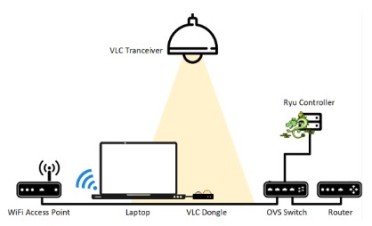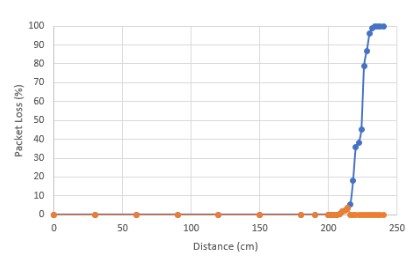In IEEE WoWMoM 2018 conference, I presented our work on an SDN-based WiFi-VLC Coupled System for Optimised Service Provision in 5G Networks. Visible Light Communication (VLC) is a powerful supplement, which has gained tremendous attention recently and has become a favorable technology in short-range communication scenarios for the Fifth Generation (5G) networks. VLC possesses a number of prominent features to address the highly demanding 5G system requirements for high capacity, high data rate, high spectral efficiency, high energy efficiency, low battery consumption, and low latency. However, this prominent performance is limited by the imperfect reception, since line of sight channel condition may not always exist in practice. The paper presents and experimentally validates a SDN-assisted VLC system, which is coupled with WiFi access technology in order to improve the reliability of VLC system, reassuring zero packet loss reception quality due to misalignment or path obstructions or when the user is moving between two consecutive VLC transmitters and experience “dead coverage zones”.

The experimental setup of this paper includes an SDN network domain, which is controlled by Ryu controller that is capable of executing python-based SDN apps. The CPE is a laptop equipped with a USB VLC receiver and an Arduino-based luminance detector, placed next to the VLC dongle.
The experimental topology complements the VLC technology with a 2.4GHz WiFi 802.11g access point, which was used in the experiment as a dynamically coupled access technology for the zones that the user has poor reception quality, such as the dead reception zones between two successive VLC transceivers. An SDN app was developed in order to handle the seamless switching of the access technology (i.e. WiFi or VLC) used each time in order to maintain good reception quality.
 As it was expected, while the user is moving away from the center of the LED light, the lx value (and respectively the SNR value) is decreasing, which means that the reception quality drops and the http-streaming video service from normal playback is starting to appear occasional pauses. Gradually the lx value reaches to zero as the users is located in a dead reception zone between two successive lamps, where the video service provision is paused/interrupted (packet loss reaches 100%/blue line). The video service playback re-initiates when the user reaches the coverage area of the next VLC transmitter, since all the lamps are broadcasting the same content, and therefore the distance from the next light source is decreasing and therefore the lm value and the SNR value are gradually increasing.
As it was expected, while the user is moving away from the center of the LED light, the lx value (and respectively the SNR value) is decreasing, which means that the reception quality drops and the http-streaming video service from normal playback is starting to appear occasional pauses. Gradually the lx value reaches to zero as the users is located in a dead reception zone between two successive lamps, where the video service provision is paused/interrupted (packet loss reaches 100%/blue line). The video service playback re-initiates when the user reaches the coverage area of the next VLC transmitter, since all the lamps are broadcasting the same content, and therefore the distance from the next light source is decreasing and therefore the lm value and the SNR value are gradually increasing.
The experiment was repeated placing the CPE at the same distances, but with the SDN controller enabled and the proposed SDN-app active and properly configured. The user requested the HTTP streaming video service and once the service started, she/he started to move from distance equal to zero with step of 30cm, towards the next VLC lamp. When she/he covered a distance of two meters (i.e. at the dead coverage zone between the two lamps), then the packet loss started to increase (as is it observed in the figure above in oragne). Then the SDN-app detected the loss of the ctrl_messages via the VLC channel and once the window of 2 seconds had been completed, the SDN-app instructed via the SDN Controller appropriate Openflow commands to be applied on the OVS switch for diverting the downloading flow to WiFi. The switching process performed seamlessly to the end-user, which resulted in maintaining the video service delivery intact, without any service interruption or quality degradation.
Read the full paper. Available here.